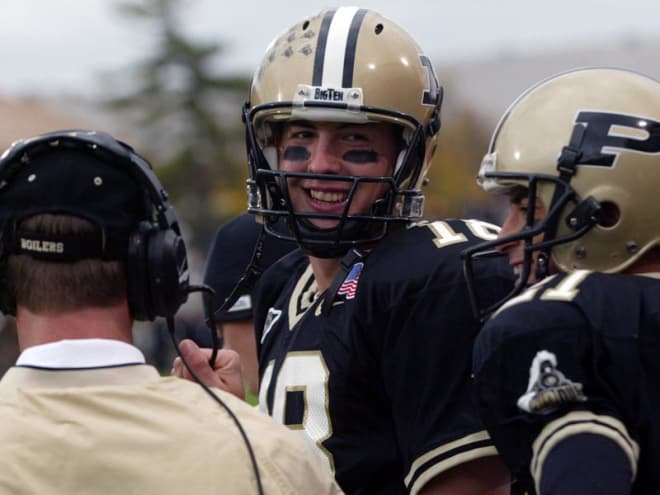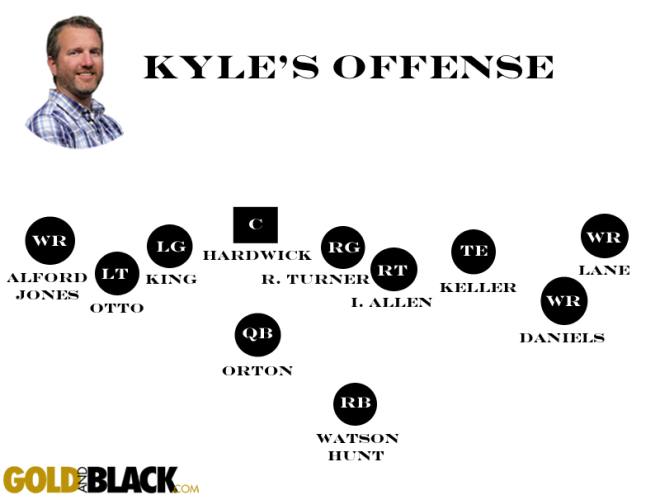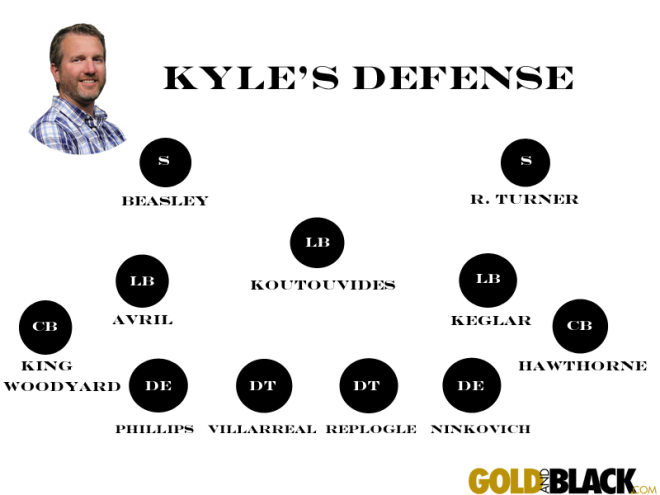The Final Word: About Kyle Charters' team
More: GoldandBlack.com's draft picks 1-100
To mark the 20-year anniversary of Purdue's dramatic turnaround in football beginning in 1997, GoldandBlack.com spent the past 10 weeks conducting a fantasy draft of sorts, compiling teams made up of the best Boilermaker players from the past two decades.
Now, Stacy Clardie, Kyle Charters, Alan Karpick and Brian Neubert review their teams and the process.


I've always tended toward defense, favoring low-scoring, grind-em-out football games in which every single yard matters.
And that makes it more interesting, in my opinion, that as this draft developed, my team centered on the offensive side, picking up piece after piece that makes it the most explosive of the four.
I love its makeup. The offense starts with Kyle Orton, of course, the third overall pick, and a player who was the best in the country during a stretch, nearly an unstoppable force that had the Boilermakers rolling in 2004. (I did consider taking Matt Light at 3, but the drop-off from Orton to the next QB was too great to pass up). After Orton — and then center Nick Hardwick, who will anchor the line — my thought process was to gather playmakers who could help push the ball down the field and soften underneath. And the combination of Brian Alford and Dustin Keller, in particular, does exactly that. Those two could run deep patterns, up the sideline up and the seam, on every snap, and it would make an effective offense, because one is likely going to be left in one-on-one coverage. Or double both, and Orton will drop it under to Chris Daniels or one of the backs.
I was disappointed when Keith Smith was picked before I could get him, as I'd be eyeing the physical receiver as my slot man. But getting Daniels as late as I did was a boon; he's exactly the fit needed in this offense: Physical, reliable and slippery enough in space — and he'll have space — to make big plays.
Ed Watson probably should have been at least the third running back taken, and he was the fifth. So getting him — I was the last to chose a RB — and then Akeem Hunt at 95 are a couple great values. I love Hunt in this offense, because as someone who won't be the focal point, he will be a homerun threat at every opportunity. Alford and Keller running deep; Randall Lane as an intermediate target; Daniels running a crossing pattern; and then Hunt slipping out of the backfield. Unstoppable.
The line is good, and better than that at two critical positions: Hardwick at center and Mike Otto at left tackle.

My defensive philosophy was pretty simple: Take the best available guys.
As it turns out, most of those players, aside from Jake Replogle, are from the first 10 years of our 20-year window. Probably good reason for that, considering those Brock Spack units were some of the best at Purdue.
The No. 7 pick, Shaun Phillips, was an easy choice, because the defensive end is so disruptive that he makes everyone else better. The rest of the D-line, with Brandon Villarreal, Replogle and Rob Ninkovich, are high-motor players, relentless in their attitudes, hungry to make plays. And they're solid both in rushing the passer and in stopping the run.
Few were as solid as Niko Koutouvides up the middle. I wanted him as my Mike and got him, picking him up at No. 23. It's an athletic group of linebackers, particularly Stanford Keglar, who is probably one of the quickest inside-the-box players of the last 20 seasons. He's a freak. Cliff Avril played both linebacker and defensive end at Purdue, probably better on the line (admittedly). Yet, in my opinion, he was the best option available at 39, not only because I could play him at linebacker but because he thinned the remaining available defensive ends.
It's a physical secondary. Adrian Beasley and Ralph Turner were solid safeties who had a knack for making big plays, and they did so during their Purdue careers. I prioritized both — actually, I thought I was only going to get one, but jumped at the chance to grab each — after the top two, Bernard Pollard and Stu Schweigert, went early. I'd been eyeing Mike Hawthorne since early in the draft, because I love the cornerback's ability and swagger, but wasn't sure where to take him. Maybe 55 was too high, but I wasn't willing to wait. I think people have forgotten how effective he was. And Brandon King, too. I wanted him because of his attitude, versatility and physicality not only the passing game but running, too. With late-pick Ashante Woodyard, King can move inside to nickel, where he might be most effective.
Some have questioned my secondary, which makes no sense. Perhaps time has made people forget how effective a group this could be.
My defense is a base 4-3 — because really, who likes nickel — but with the flexibility to shift to five-DB packages. And Avril and Ninkovich can flip positions, if needed.
And hey, I have an extra tight end too, with the possibility of Ninkovich or Phillips giving me some snaps on offense.
Closing Argument
I sought balance in this draft.
And after 25 picks, I found it. No position group is a glaring weakness, nor was any pick a major reach.
Built around it's deep-ball ability, the offense will be able to score in a variety of ways, via big plays or by grinding for yardage. In 21st Century football, the offense has the edge, even if the defense wins an individual battle here or there. I'd take an Orton/Alford/Keller trio over any combination of defensive backs Purdue has had in the last 20 years. That's where the game is won.
The defense can get after the quarterback, from the edges and up the middle, has quickness and athleticism at linebacker, and playmakers in the secondary, including rangy safeties, a coverage cornerback and couple others who are two of the most physical in the last two decades.
And if the leadership factor matters on this fantasy team, then my group oozes it.
Last Things
If I could have any do-overs, it might be to have strongly considered taking Tim Stratton somewhere in the 40s. Because pairing him with Keller would have been an intriguing dynamic and would have given my team the best two tight ends of the last 20 years.
Regardless, I'm happy with how my team developed, particularly a string of what I felt like were quality picks toward the end; my last six picks: Daniels, King, Watson, Woodyard, Hunt and Ike Jones. That's where the draft was ultimately decided.
Charters Pick-By-Pick
Round 1: No. 3 Kyle Orton
Round 2: No. 7 Shaun Phillips
Round 3: No. 11 Nick Hardwick
Round 4: No. 15 Dustin Keller
Round 5: No. 19 Brian Alford
Round 6: No. 23 Niko Koutouvides
Round 7: No. 27 Adrian Beasley
Round 8: No. 31 Mike Otto
Round 9: No. 35 Rob Ninkovich
Round 10: No. 39 Cliff Avril
Round 11: No. 43 Ian Allen
Round 12: No. 47 Brandon Villarreal
Round 13: No. 51 Jake Replogle
Round 14: No. 55 Mike Hawthorne
Round 15: No. 59 Ralph Turner
Round 16: No. 63 Stanford Keglar
Round 17: No. 67 Randall Lane
Round 18: No. 71 Brandon King
Round 19: No. 75 Rob Turner
Round 20: No. 79 Chris Daniels
Round 21: No. 83 Jason King
Round 22: No. 87 Edwin Watson
Round 23: No. 91 Ashante Woodyard
Round 24: No. 95 Akeem Hunt
Round 25: No. 99 Isaac Jones

Membership Info: Sign up for GoldandBlack.com now | Why join? | Questions?
Follow GoldandBlack.com: Twitter | Facebook
More: Gold and Black Illustrated/Gold and Black Express | Subscribe to our podcast
Copyright, Boilers, Inc. 2017. All Rights Reserved. Reproducing or using editorial or graphical content, in whole or in part, without permission, is strictly prohibited.

